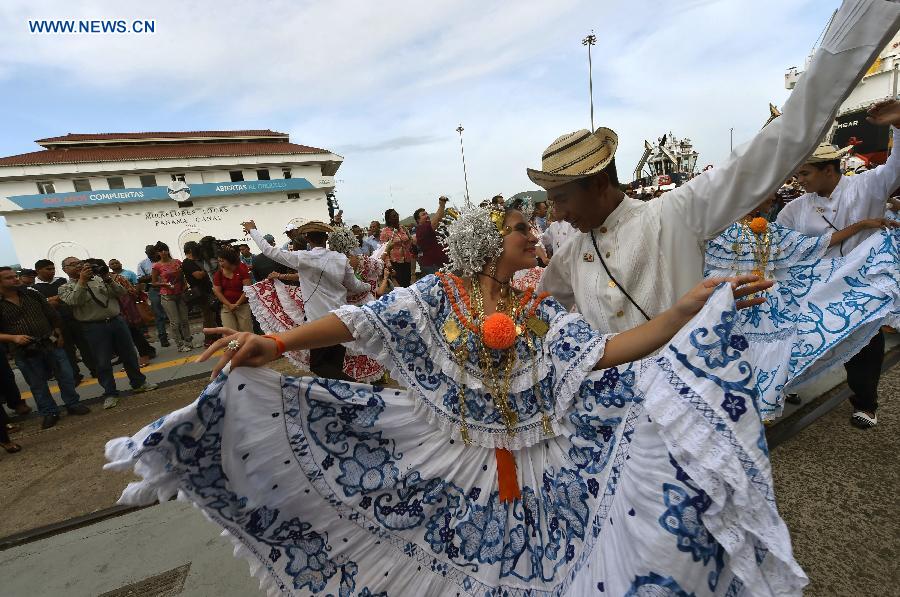Panama Canal celebrates 100th anniversary amid expansion projects

PANAMA CITY, Aug. 15 (Xinhua) -- Panama Canal, one of the greatest engineering feats in the world, celebrated its 100th anniversary here on Friday, amid ongoing expansion works and proposals.
At 8:00 a.m. local time, the ship "Lowlands Kamsar" slowly passed by the Miraflores Locks of the Panama Canal with ringing siren, commemorating the first ship which passed through the Panama Canal 100 years ago.
Sailors on the deck waved the flags of Panama. Dancers and bands performed besides the locks.
A highlight of the ceremony was an oversized cake bearing a replica of the Miraflores locks, where the event was taking place, complete with a passing ship whose deckhands waved miniature Panamanian flags.
The Panama Canal, approximately 80 km long between the Atlantic and Pacific Oceans, saves about 12,875 kilometers and half the time from a journey around the southern tip of South America, Cape Horn, according to the official website of the canal.
Nowadays, the 100 years old waterway serves more than 144 maritime routes connecting 160 countries and regions, and reaching some 1,700 ports in the world. It manages about 5 percent of the world's shipments.
In a speech to those gathered, Panama Canal administrator Jorge Luis Quijano began by recalling that the U.S. steamship SS Ancon, with 200 passengers on board, including then president Belisario Porras, inaugurated the waterway in 1914.
The U.S. operated the canal until late 1999, when it handed over the management of the waterway to Panama.
Following the ceremony, the Miraflores locks were opened to the public for a tour of the site and a folkloric show featuring regional songs and dances.
The Panamanian government announced the minting of 3 million commemorative 50-cent coins and 2,000 pure silver coins to mark the centennial.
THE CANAL HISTORY
The earliest mention of a canal across the Isthmus of Panama dated back to 1534, when Charles V, Holy Roman Emperor and King of Spain, ordered a survey for a route through the Americas.
More than 3 centuries later, the French made the first attempt to link the oceans in 1881, but had to stop because of engineering problems and high mortality due to disease.
In 1903, the United States supported a revolution that led to the independence of Panama from Colombia. The new Panamanian government signed the Hay-Bunau-Varilla Treaty, which allowed the U.S. to build the Panama Canal and provided for perpetual control of a zone five-miles wide on either side of the canal.
After 10 years'construction, with more than 25,000 workers died because of malaria, yellow fever and accidents, the waterway inaugurated in August 1914. It was then considered one of the seven wonders of the modern world.
However, the canal contributed little to the Panamanian economy under the control of the U.S.
Anger flared in the 1960s and led to anti-American riots in Panama.
At midnight on Dec. 31, 1999, the sovereignty of the canal was returned to Panama according to the 1977 handover treaty signed by the U.S. and Panamanian governments.
EXPANSION PROJECT TOWARDS THE FUTURE
Manuel Benitez, assistant administrator of the canal, said the objective over the next 100 years will be to continue providing ships a safe and expedient passage between the Atlantic and Pacific oceans, with a new and expanded waterway.
Entering the new century, the canal designed nearly 100 years ago to accommodate ships 267 meters in length and 28 meters wide, is too small to handle the post-Panamax ships that are three times as big, making it necessary to expand by building a new set of docks.
In 2007, the Panamanian government began the expansion project of the interoceanic canal which will double the capacity of the canal by creating a new lane of traffic.
A key part of the expansion work is the construction of floodgates in the Pacific and the Atlantic, which will allow the post-Panamax vessels to pass by the canal.
The expansion works was originally planned to complete Friday for the canal's 100th anniversary, but for some reason it had to be postponed until 2016.
Quijano announced earlier this month potential new investment plans to ensure that the waterway remains competitive in the future.
The plans include a possible fourth set of locks and the construction of another port on the Pacific side, a logistics park -- or special economic zone -- and a gas refueling station for vessels, Quijano told Xinhua.
A fourth set may not be needed for another 10 years, he said, given that the current expansion project is expected to reduce congestion by 97 percent.
However, Quijano believed that trade ships will continue to get bigger, requiring new locks. Also, in the future, the industry expects to see more vessels fueled by liquefied natural gas (LNG) and that these ships will be looking for routes with LNG fueling stations.
Nicaragua, in conjunction with international investors, plans to build the Nicaragua Canal. Construction is expected to begin at the end of this year and be completed in six years.
HEADLINES
- Do shipping markets want Biden or Trump for the win?
- All 18 crew safe after fire on Japanese-owned tanker off Singapore
- Singapore launching $44m co-investment initiative for maritime tech start-ups
- Cosco debuts Global Shipping Industry Chain Cooperation Initiative
- US warns of more shipping sanctions
- China continues seaport consolidation as Dalian offer goes unconditional